
9
tool may stall or overheat the motor.
9. After the cut is complete, release the trigger and
wait for the blade to stop completely. Raise the
saw head and remove the workpiece.
WARNING!
If small cut-off pieces get caught in the guard area,
remove battery pack before clearing.
Making a Sliding Cut (Cross Cut)
Wider workpieces can be cut using the sliding
mechanism. Always use chop cut whenever possible.
4
2
3
1
1. Make sure that the chop lock is unlocked, the
slide rail transport lock is loose, and the saw head
moves freely back and forth.
2. Select the desired angles and adjust the fences to
ensure fence hand holds are positioned to keep
hands out of the No Hand Zone.
3. Place the workpiece on the turntable and line
up the cut.
4. Insert battery pack.
5. Support the workpiece using any of the methods
described in "Support the Workpiece Properly".
6. WARNING!
Keep hands out of the No Hands
Zone at all times during use. Contact with blade
will result in serious injury.
7. Raise saw head and pull it out OVER the work-
piece WITHOUT cutting.
8. Start the motor. Wait a few seconds for the blade
to reach full speed.
WARNING!
Do not allow
the blade to contact the workpiece while tool is
ramping up.
9. Press down on saw head.
10. Push saw through the cut.
WARNING!
Return saw
head to the full rear position after each crosscut
operation.
11. After the cut is complete, release the trigger and
wait for the blade to stop completely. Raise the
saw head and remove the workpiece.
WARNING!
If small cut-off pieces get caught in the guard area,
remove battery pack before clearing.
APPLICATIONS
WARNING
Do not cut stone, brick, concrete,
magnesium, or ferrous metals
(iron, steel, stainless steel, or alloys of these
metals) with this saw.
Do not use abrasive wheels with this saw.
Dust created by cutting these materials and/or
using abrasive cut-off wheels can jam the blade
guard and possibly cause personal injury.
Recommended Materials and Applications
The following materials can be cut with the com-
pound sliding miter saw. There are many types of
saw blades available. Always use the proper blade
for the particular material and application. Use only
10" sliding miter saw blades
rated at least 4000 RPM.
•
Wood -
solid wood, plywood, particle board, MDF
(medium density fiberboard), HDF (high density
fiberboard), melamine laminated particle board,
formica laminates, hardboard (masonite).
•
Plastics -
PVC, CPVC, ABS, solid surfacing materi-
als (such as Corian
®
), and other plastic materials.
When cutting plastic, avoid overheating the blade
and blade teeth to prevent melting the workpiece.
•
Nonferrous Metals -
aluminum, brass, copper, and
other non-ferrous materials.
Cutting Non-Square Materials
Cutting Round (Cylindrical) Materials
"V" shaped blocks can be used to support round
materials like closet rod and plastic pipe.
Aluminum Sash and Other
Channel Type and Materials
Aluminum sash material can be supported with blocks
to prevent it from deforming while it is being cut.
Clamp
Fence
Table
Wood support
block
Aluminum
material
Wood support
block
Miter Range
Miter Detents (Stops)
0° to 50° Left
0° to 60° Right
0°, 15°, 22.5°, 31.62°, 45°, 50° Left
0°, 15°, 22.5°, 31.62°, 45°, 60° Right
Bevel Range
Bevel Detents (Stops)
0° to 48° Left
0° to 48° Right
0°, 22.5°, 33.85°, 45°, 48° Left
0°, 22.5°, 33.85°, 45°, 48° Right
Base Molding
Capacity
Nested Crown
Capacity
5-3/4" at 0°
5-3/4" at 45° Left
5-3/4" at 45° Right
5-1/4"










































